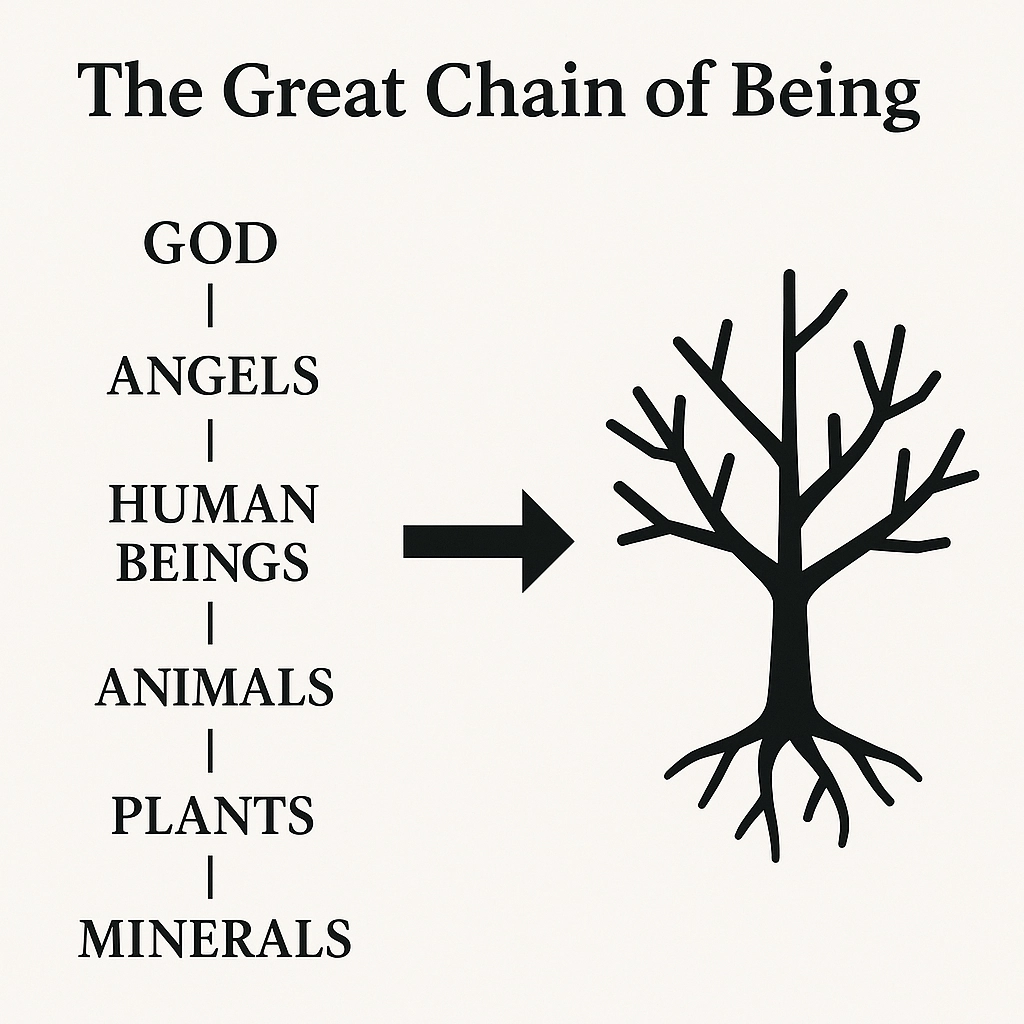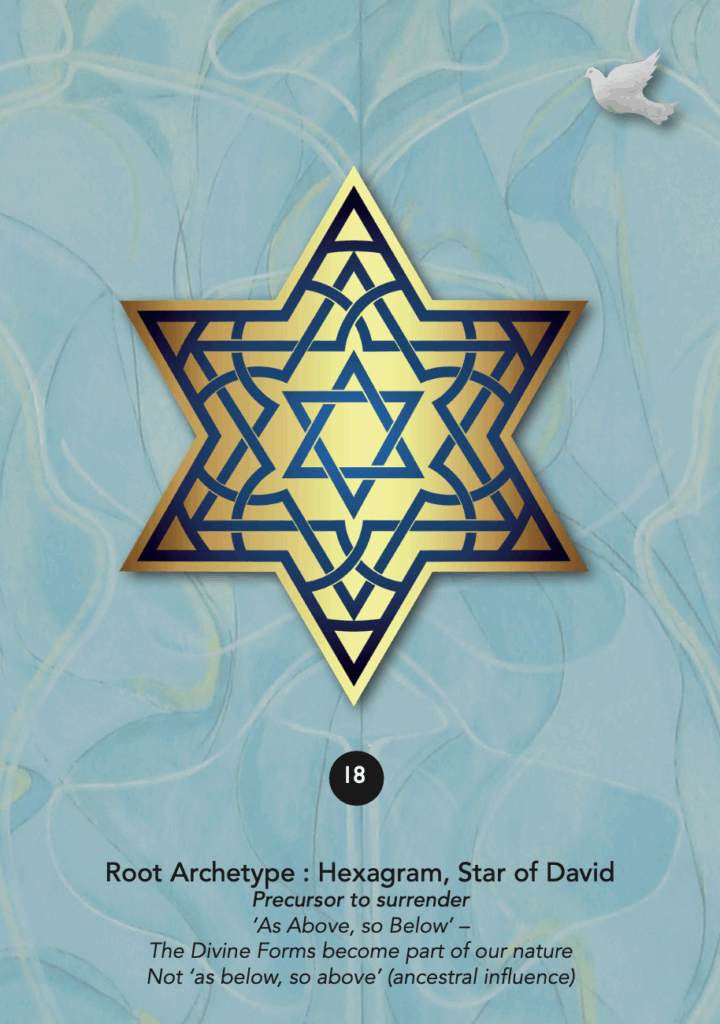The Great chain of Being
The Great Chain of Being

From Celestial Hierarchy to Phylogenetic Trace
The Great Chain of Being is one of the longest-standing ontological metaphors in the Western imagination. It emerged from a confluence of Platonic idealism, Aristotelian order, and early Christian cosmology. It depicted all existence arranged in vertical sequence—from the incorporeal and divine at the top, to the inert and base below.
🕊 A Note on Emanation and Return
God—the Implicate Reality—sat at the summit: pure spirit, the unmoved mover. This Origin did not act upon the world from a distance, but unfolded itself, emanating essence into the many layers of being. In our case, that essence landed here—on this dense, animate sphere we call Earth.
It is as though the soul, once turned outward into form, now begins its journey inward—a return to Source. In the classic metaphysical order, archangels, seraphim, and angels came before human beings, followed by animals, plants, and, finally, minerals. Each realm is not lesser, but foundational—what is below supports and enables what is above.
Our soul has passed through these layers—not as a punishment or exile, but as participation. Now, in human form, it continues its development, not through ascent in space, but through inner refinement, remembering its origin through successive stages of consciousness.
This is not evolution in the modern biological sense, but emanation—a radiant descent of essence into form, and a quiet ascent of awareness back toward unity.

It was a deeply ordered view of reality: Heaven over Earth, soul over body, spirit over matter, man over woman, civilised over primitive, human over animal. This organisation brought with it both a mythic coherence—and a troubling legacy.
✴ The Hexagram: As Above, So Below

The hexagram, two interlaced triangles, is an ancient symbol of relational symmetry: one pointing upward, one pointing downward. It expresses the alchemical and hermetic principle as above, so below—the idea that the spiritual and the material, the inner and the outer, the higher and the lower, are mirrored and intertwined.
Traditionally, the descending triangle symbolised spirit entering matter—emanation, divine essence clothed in form. The ascending triangle represented matter aspiring toward spirit—return, refinement, and remembrance.
But in our current world, something has shifted.
We no longer live in a culture that recognises this symmetry. The above has been forgotten, and so the below grows heavy. The triangle that once pointed upward is dimmed, often inverted. We carry unconscious content—ancestral residue, cultural fragmentation, unprocessed grief—and it tugs at the higher registers of our being.
In this inversion, the lower does not merely reflect the higher. It distorts it.
And yet, this distortion is not failure—it is invitation.
When we turn toward what lies beneath—our shadowed inheritance, the overlooked, the disowned—it begins to transmute.
The lower triangle becomes visible as the epigenetic thrust, the presence of the dæmon—a force within, not to be feared, but recognised.
As this is met, the upward path reappears—not as repetition, but as clarity freed from the past.
The being becomes receptive to the descending Spirit, to the archetypal intelligences—Plato’s Divine Forms—that seek expression through form.
In this, the constitutional part of us ascends—naturally, unforced, no longer encumbered by inherited disruption or the residue of unresolved experience.
In this way, what lies below does not invert the order, but redeems it—restoring the living dialogue between descent and ascent.
The hexagram becomes whole again.
As above, so below.
And as below, so above.
A Sacred Taxonomy—and Its Shadows
The Chain wasn’t merely a metaphysical map—it was also a theological and political framework. It justified social rigidity, spiritual elitism, and even colonial conquest. Its order was sanctified; its inequalities presumed natural. But beneath its distortions lay a symbolic intuition—that life unfolds in nested layers, each with its own kind of interiority and function.
From Chain to Tree
By the 18th century, the Great Chain began to lose ground. Enlightenment science and evolutionary theory replaced divine fixity with branching complexity. The Linnaean system introduced classification; Darwin replaced the ladder with a tree.
Human beings were no longer the pinnacle of a static hierarchy but one twig among many. Life was not descending from spirit but ascending through form—from microbe to multicellular complexity. The metaphor shifted: from verticality to branching, from hierarchy to kinship, from divine order to relational process.
A Phylogenetic Echo
Still, the Chain held a symbolic accuracy. It sensed a trajectory of unfolding—from inert to animate, from plant to animal, from body to consciousness. This arc is echoed in phylogenetics and even in embryology. The foetus does not merely grow, it recapitulates—bone mineralising, structures branching like trees, coils forming like serpents, until the human form takes shape. Not hierarchy, but developmental echo.
- Minerals gave rise to organic chemistry
- Plants brought rooted life and rhythmic growth
- Animals added mobility and instinct
- Humans inherited all of it—and added memory, language, and myth
Towards a Living Ontology
What remains useful is not the rigidity of the Chain, but its aspiration. The notion that being is not flat. That some realities are denser, others more interior. That matter has layers. That consciousness unfolds through process, pattern, and mystery.
We no longer need to see ourselves at the top, but we might still feel ourselves on a path—a lineage—moving through and with all of life, participating in something ancient, layered, and quietly reaching upward, or ascent back towards our Origin or Source